Studio 18 Ltd - Tel +44 (0) 116 2862376 - Fax +44 (0) 116 2862638 - info@studio18ltd.co.uk
Manufacturer and Supplier of Quality Wholesale Body Piercing Jewellery Products Trade Only.
Studio 18 Ltd Registered in England & Wales No:4372438 VAT No:GB 786 751 771 © Copyright 2014 all rights reserved All details subject to change with out notification.
Body Jewellery measurments - size Conversion Chart
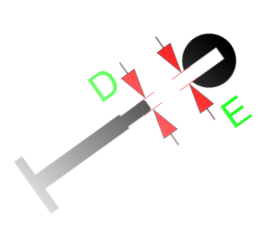
How Studio 18 measure there
Jewellery for an acurate fit for a
sucsesfull Body Piericng
Ball Closure Rings measurements




“A” Would represent the “Thickness” or “Gauge”
of the Ring in Millimeters (mm)
“B” Would represent the inside “Diameter”
of the Ring in millimeters (mm)
Titanium Ball Closure Ring Uses:
Barbell measurements






“A” Would represent the
“Thickness” or “Gauge” of the
Barbell in Millimeters (mm)
“B” Would represent the: “Length” of
the Barbell in millimeters (mm)
“C” Would represent the:
“Ball size” or “Ball Diameter”
in millimeters (mm)
“D” Would represent the:
“Thread Size” of the Barbell
in millimeters (mm)
“E” would represent the:
“Thread size of the Ball”
in millimeters (mm)
Titanium Barbell Uses:
Labret measurements



Labret Uses:



“A” Would represent the
“Thickness” or “Gauge” of the
Labret in Millimeters (mm)
“B” Would represent the: “Length”
of the Barbell in millimeters (mm)
“A” Would represent the:
“Ball size” or “Ball Diameter”
in millimeters (mm)
“D” Would represent the:
“Thread Size” of the labret
in millimeters (mm)
“E” would represent the:
“Thread size of the Ball” in
millimeters (mm)
Curved Barbell measurements




“C” Would represent the
“Thickness” or “Gauge” of the
Barbell in Millimeters (mm)
Curved Barbell Uses:
“B” Would represent the: “Length”
of the shaft in millimeters (mm)
“A” Would represent the:
“Bottom Ball size” or “Ball Diameter”
in millimeters (mm)
Navel Barbell measurements


“D” Would represent the
“Thickness” or “Gauge” of the Shaft
in Millimeters (mm)
Navel Barbell Uses:


“C” Would represent the:
“Top Ball size” or “Ball Diameter”
in millimeters (mm)
Circular Barbell measurements


“C” Would represent the
“Thickness” or “Gauge” of the Ring
in Millimeters (mm)
“B” Would represent the inside “Diameter”
of the Ring in millimeters (mm)
“A” Would represent the:
“Top Ball size” or “Ball Diameter”
in millimeters (mm)


Circular Barbell Uses:
Surface Bars measurements

Surface Bar Uses:







Body Jewellery conversion chart
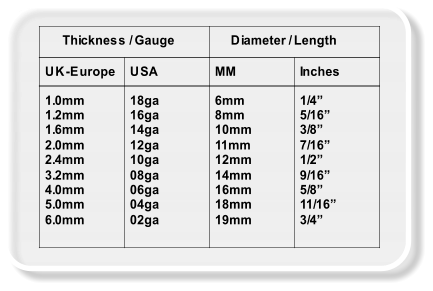






















Download a pdf Copy


Download a pdf Copy


Download a pdf Copy
“A” Would represent the:
“Ball size” or “Ball Diameter”
in millimeters (mm)
“B” Would represent the:
“Length” of the Labret in
millimeters (mm)
“C” Would represent the:
“Ball size” or “Ball Diameter”
in millimeters (mm)
“B” Would represent the:
“Thread Size” of the bar
in millimeters (mm)
“C” Would represent the
“Thickness” or “Gauge” of the
Shaft in Millimeters (mm)
“D” Would represent the
“Distance you would mark
to pierce” (mm)
“B” Would represent the:
“Length” of the Bar in
millimeters (mm)

We are Open
Tel: 0116 2862376


- Body Piercing Needles
- Body Piercing Clamps
- Gloves
- Sterilisation and Disinfectant
- Biopsy Punches and Scalpels
- New Products
- Medical Dressings Swabs Plasters
- COSHH Data Sheets
- Studio Supplies
- Biohazard Spill Kits
- Paper products
- Soaps and Hand scrubs
- Medical Page
- Kidney Dishes - Trays
- Body Piercing Aftercare
- Face Shields - PPE - Face Masks
- Purified Autoclave Water

Body Jewellery measurments - size Conversion Chart
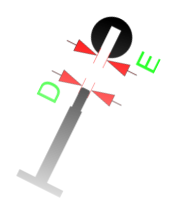
How Studio 18 measure there Jewellery for
an acurate fit for a sucsesfull Body Piericng












Download a pdf Copy
Ball Closure Rings measurements
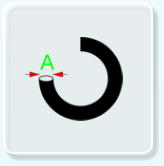
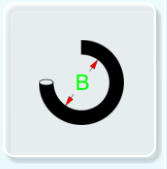
“A” Would represent the
“Thickness” or “Gauge” of
the Ring in Millimeters (mm)
“B” Would represent the
inside “Diameter” of the
Ring in millimeters (mm)


Titanium Ball Closure Ring Uses:
Barbell measurements



“A” Would represent the
“Thickness” or “Gauge” of the
Barbell in Millimeters (mm)
“B” Would represent the: “Length”
of the Barbell in millimeters (mm)
“C” Would represent the:
“Ball size” or “Ball Diameter”
in millimeters (mm)
“D” Would represent the:
“Thread Size” of the Barbell
in millimeters (mm)
“E” would represent the:
“Thread size of the Ball” in
millimeters (mm)
Titanium Barbell Uses:
Labret measurements



“A” Would represent the
“Thickness” or “Gauge” of the
Labret in Millimeters (mm)
“D” Would represent the:
“Thread Size” of the labret
in millimeters (mm)
“E” would represent the:
“Thread size of the Ball”
in millimeters (mm)
“B” Would represent the:
“Length” of the Labret in
millimeters (mm)
“C” Would represent the:
“Ball size” or “Ball Diameter”
in millimeters (mm)
Labret Uses:
“B” Would represent the: “Length”
of the Barbell in millimeters (mm)
“A” Would represent the:
“Ball size” or “Ball Diameter”
in millimeters (mm)
Curved Barbell measurements


“C” Would represent the
“Thickness” or “Gauge” of the
Barbell in Millimeters (mm)
Curved Barbell Uses:
“B” Would represent the:
“Length” of the shaft in
millimeters (mm)
“A” Would represent the:
“Bottom Ball size” or “Ball Diameter”
in millimeters (mm)
“D” Would represent the
“Thickness” or “Gauge” of the
Shaft in Millimeters (mm)
Navel Barbell Uses:


“C” Would represent the:
“Top Ball size” or “Ball
Diameter”
in millimeters (mm)
Navel Barbell measurements
Circular Barbell measurements
“C” Would represent the “Thickness”
or “Gauge” of the Ring in Millimeters
(mm)
“B” Would represent the inside “Diameter”
of the Ring in millimeters (mm)
“A” Would represent the:
“Top Ball size” or “Ball Diameter”
in millimeters (mm)


Circular Barbell Uses:
Surface Bars measurements




“A” Would represent the:
“Ball size” or “Ball Diameter”
in millimeters (mm)
“B” Would represent the:
“Thread Size” of the bar
in millimeters (mm)
“C” Would represent the
“Thickness” or “Gauge” of
the Shaft in Millimeters (mm)
“D” Would represent the
“Distance you would
mark to pierce” (mm)
“B” Would represent the:
“Length” of the Bar in
millimeters (mm)
Surface Bar Uses:
Body Jewellery conversion chart





Studio 18 Ltd
Registered in England & Wales No:4372438 VAT No:GB 786 751 771
© Copyright 2014 all rights reserved All details subject to change with out notification.

Studio 18 Ltd - Tel +44 (0) 116 2862376
info@studio18ltd.co.uk
Manufacturer and Supplier of Quality
Wholesale Body Piercing Jewellery Products
Trade Only.


- Body Piercing Needles
- Body Piercing Clamps
- Gloves
- Sterilisation and Disinfectant
- Biopsy Punches and Scalpels
- Medical Dressings Swabs Plasters
- New Products
- COSHH Data Sheets
- Studio Supplies
- Biohazard Spill Kits
- Medical
- Paper Products
- Soap and Hand scrub
- Medi Products
- Kidney Dishes - Trays
- Body Piercing Aftercare
- Face Shields - PPE - Face Masks



























